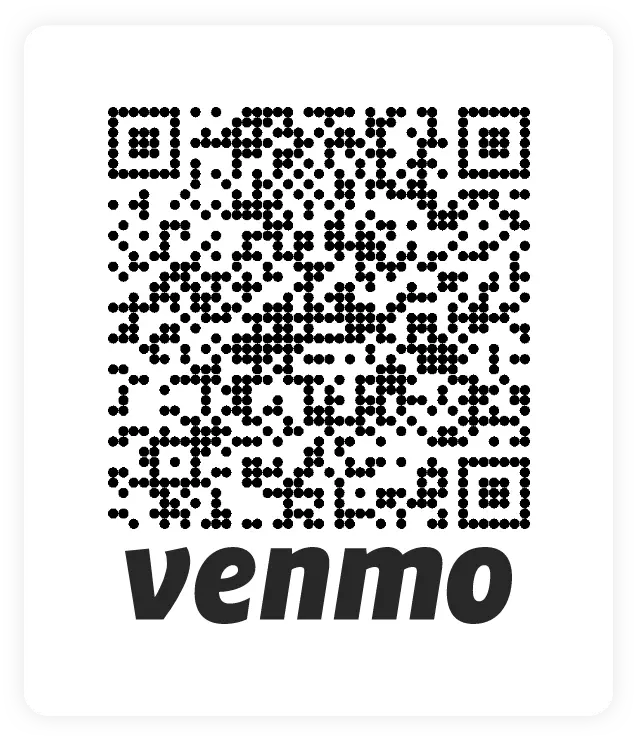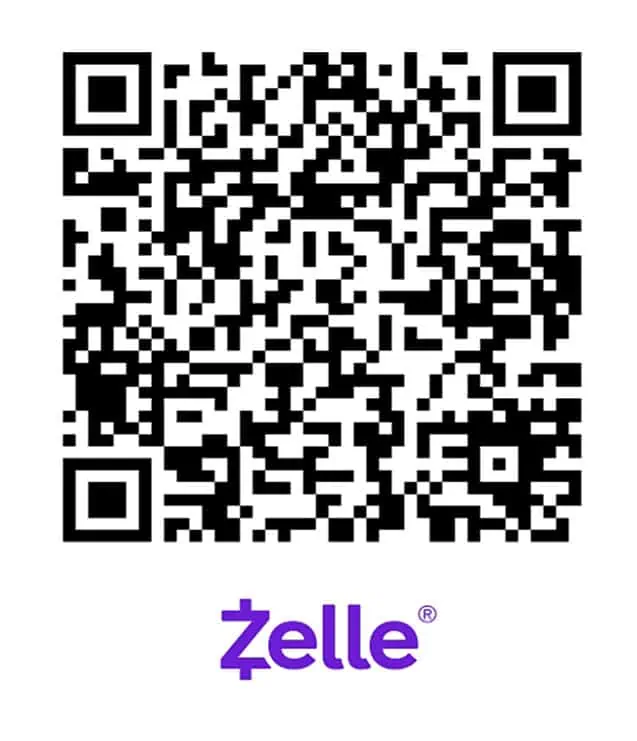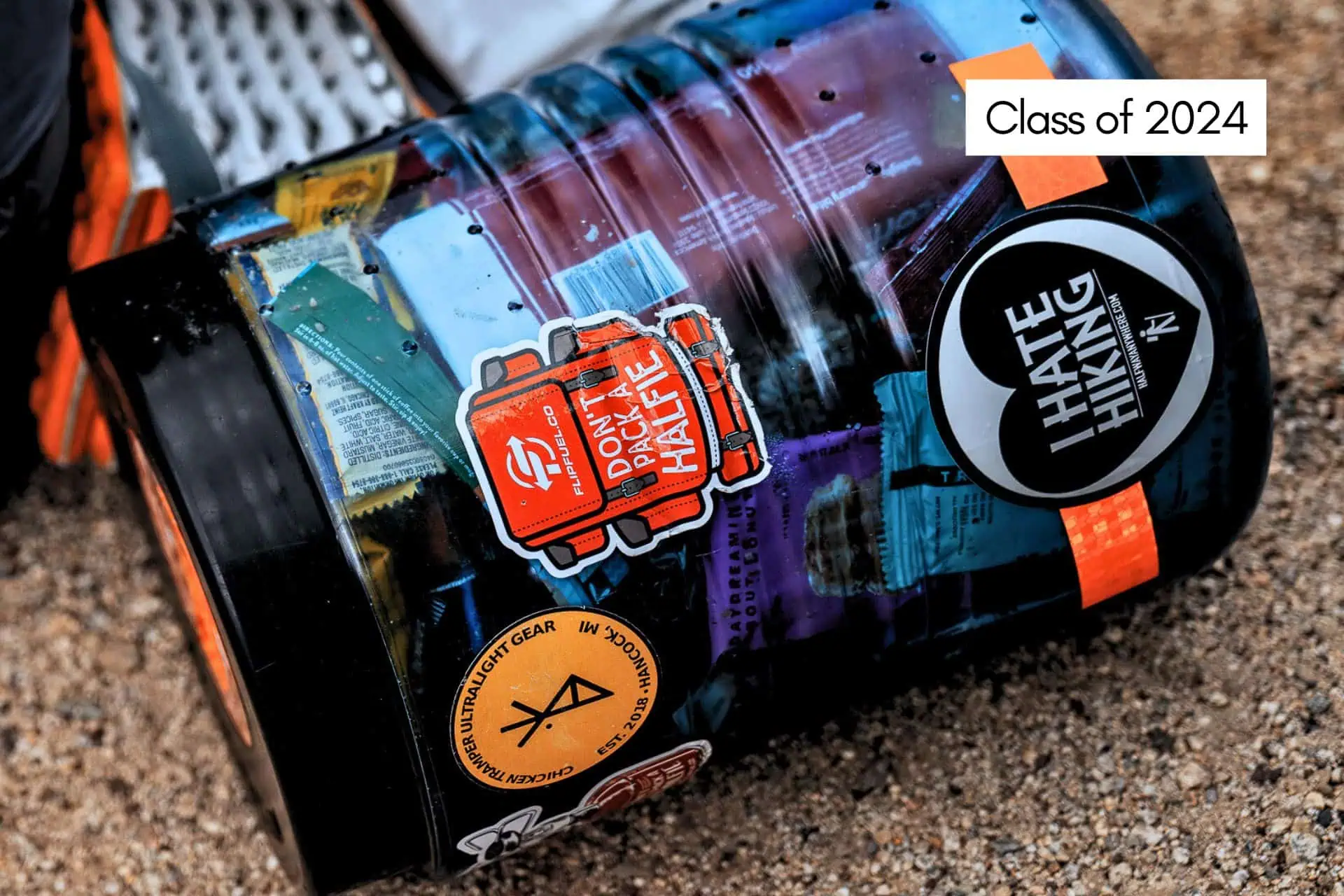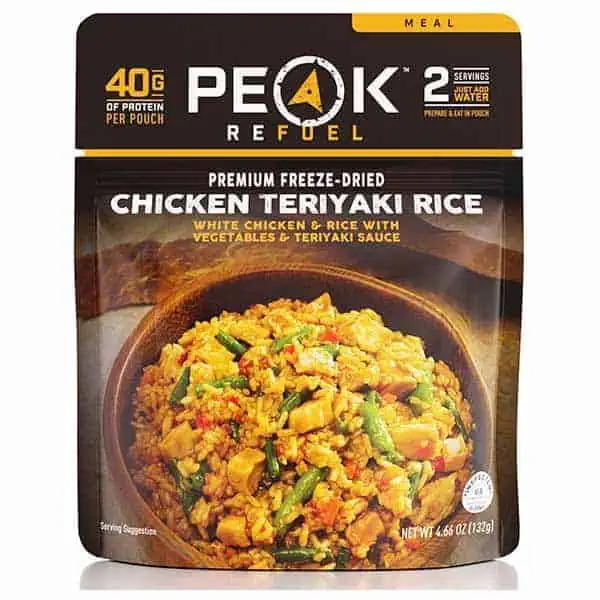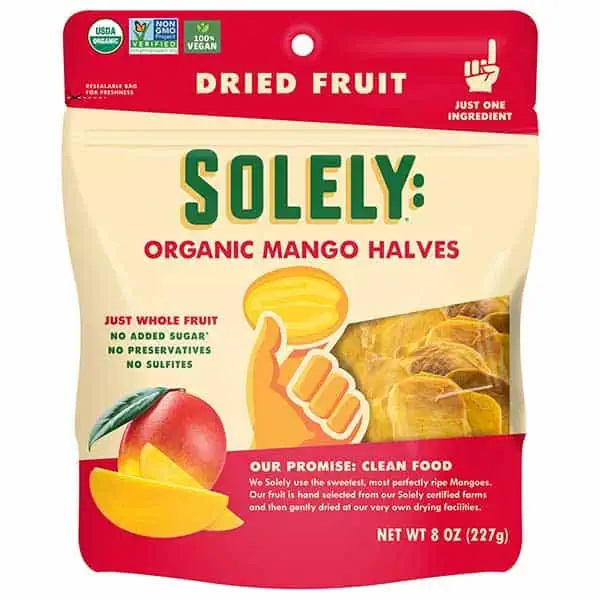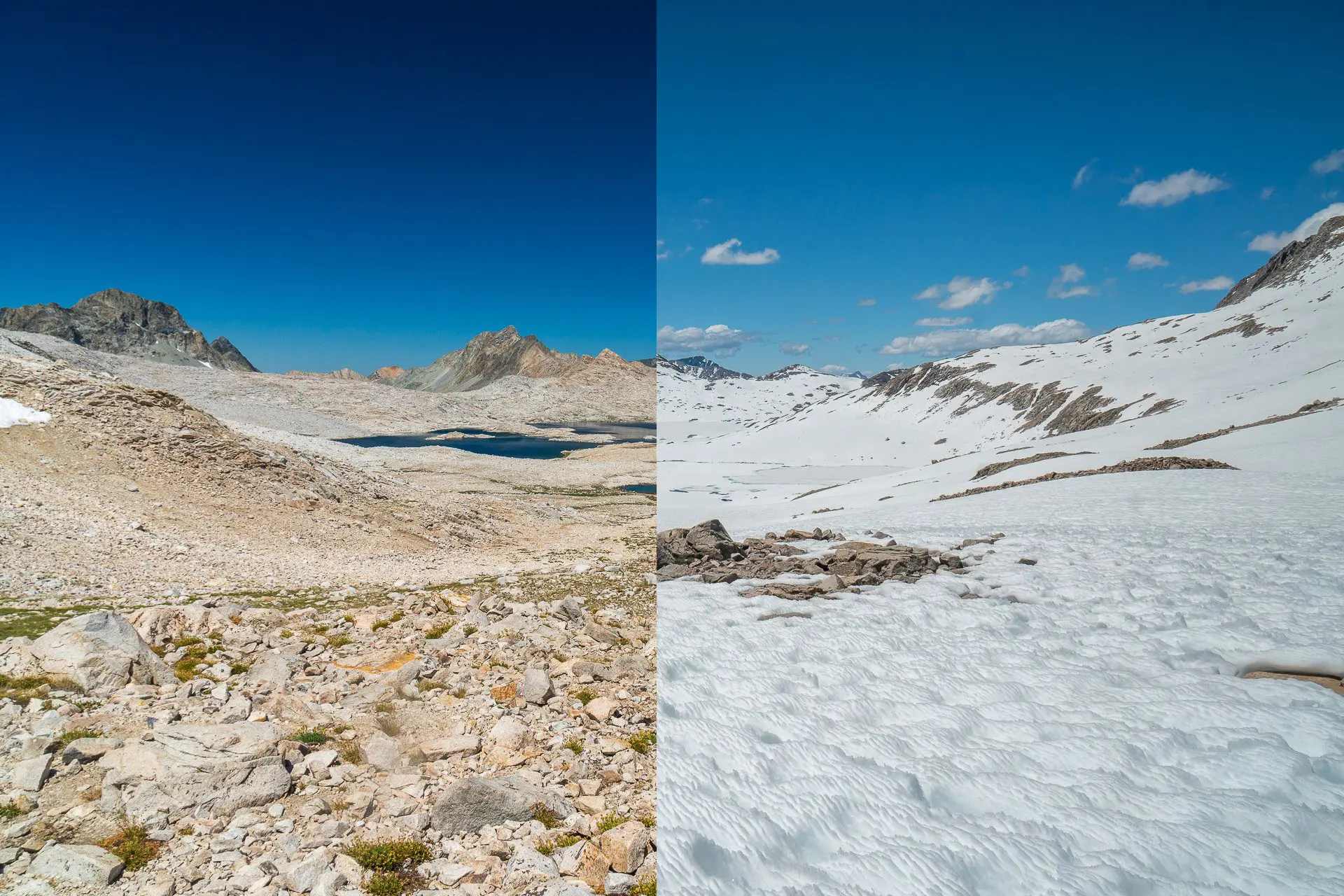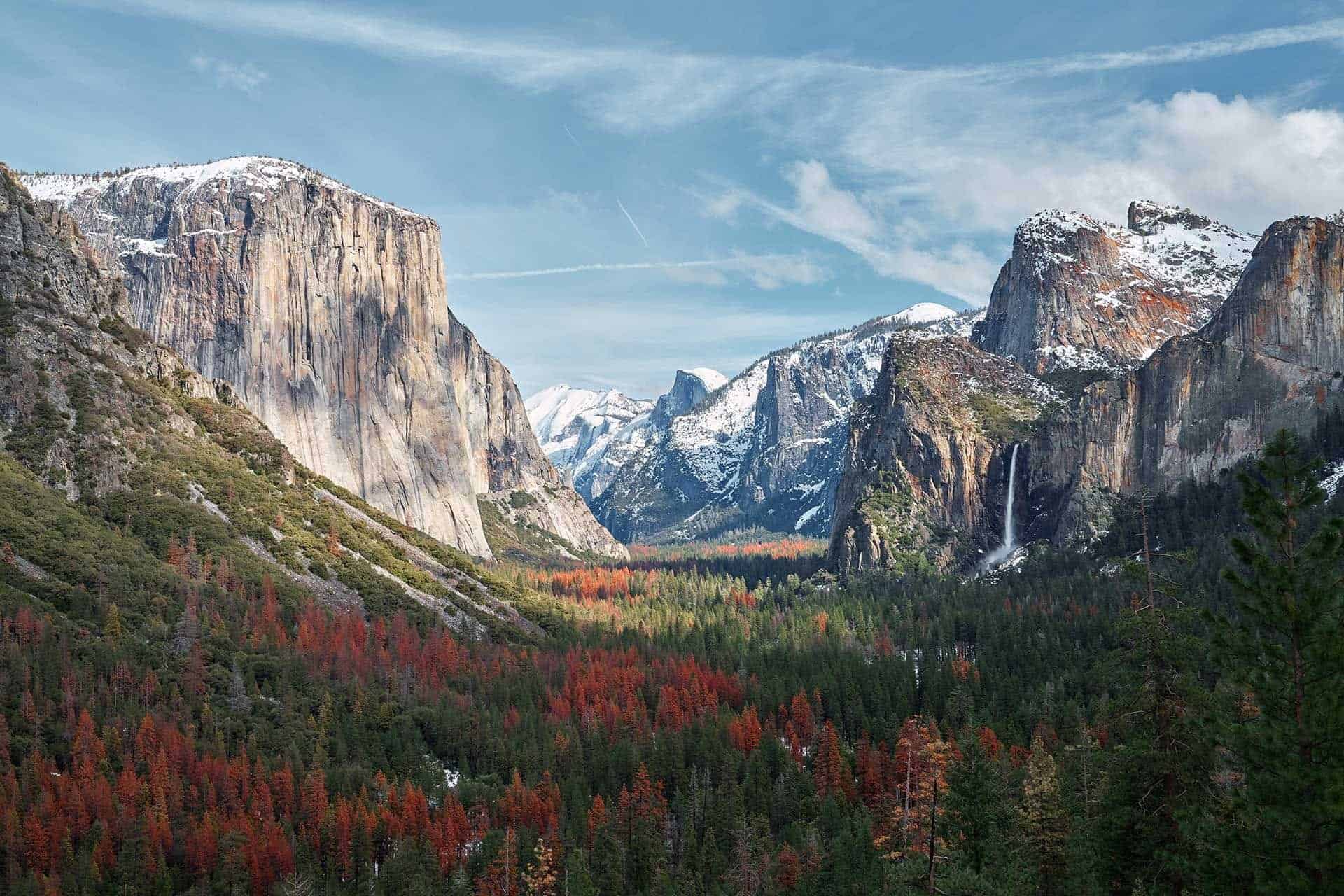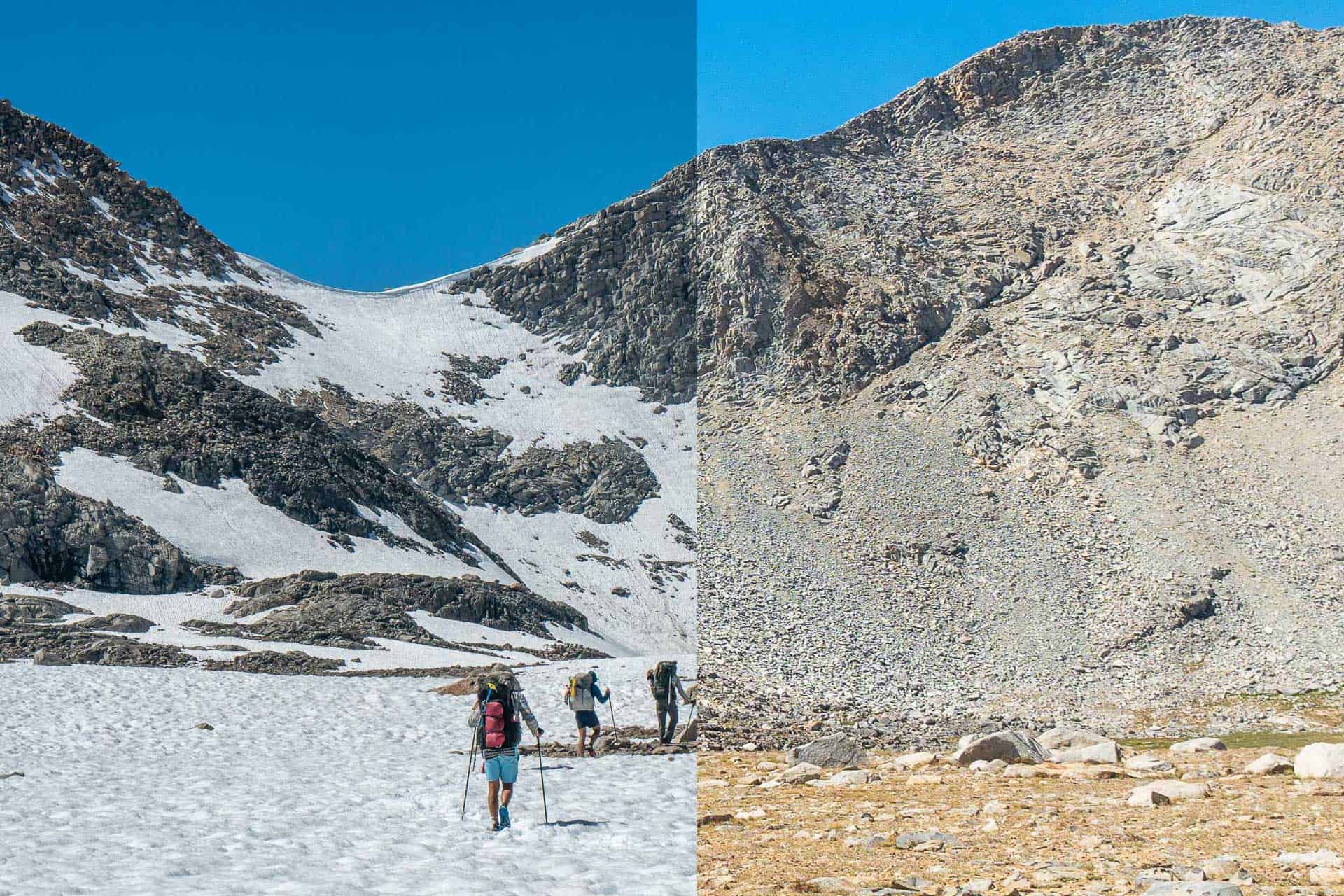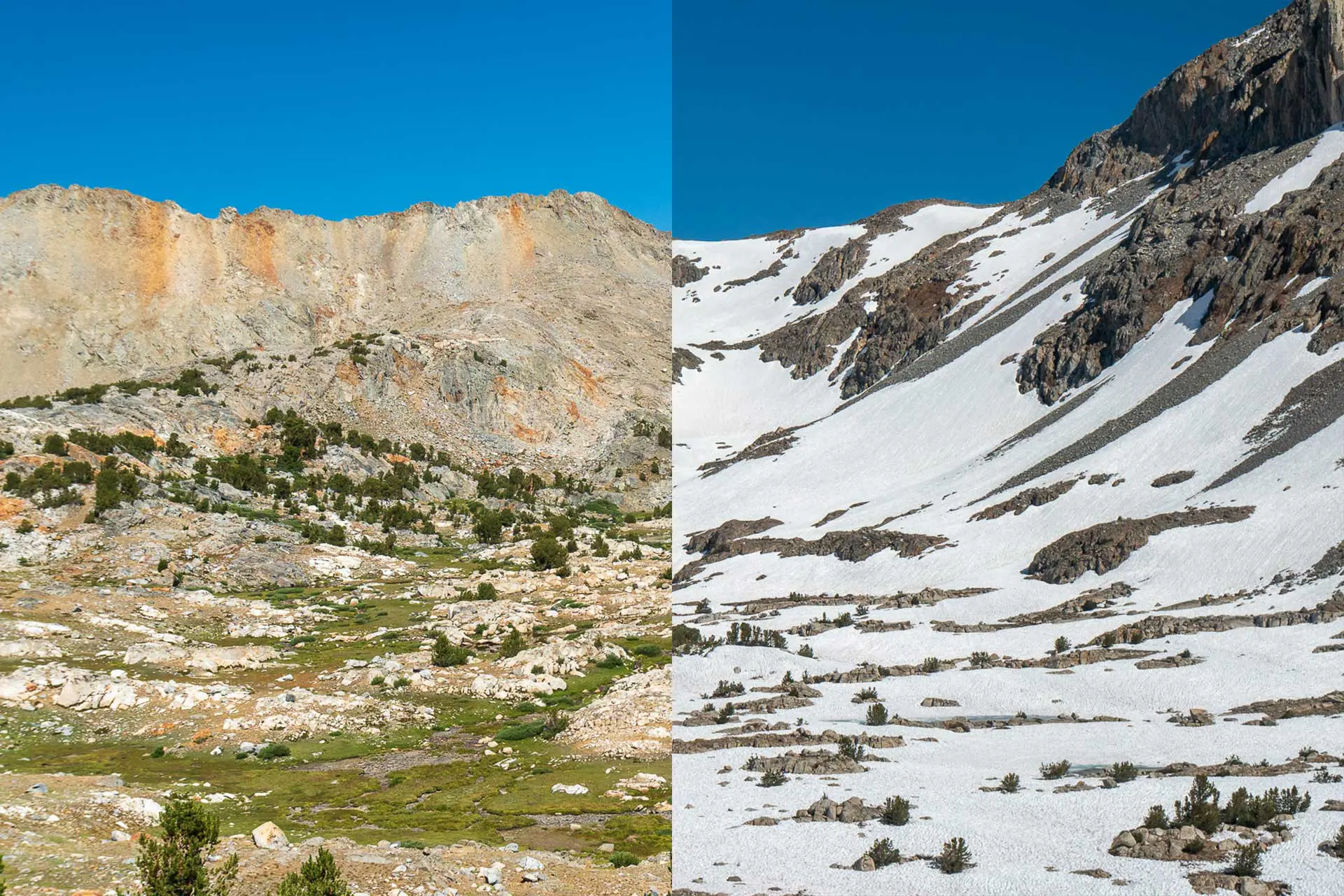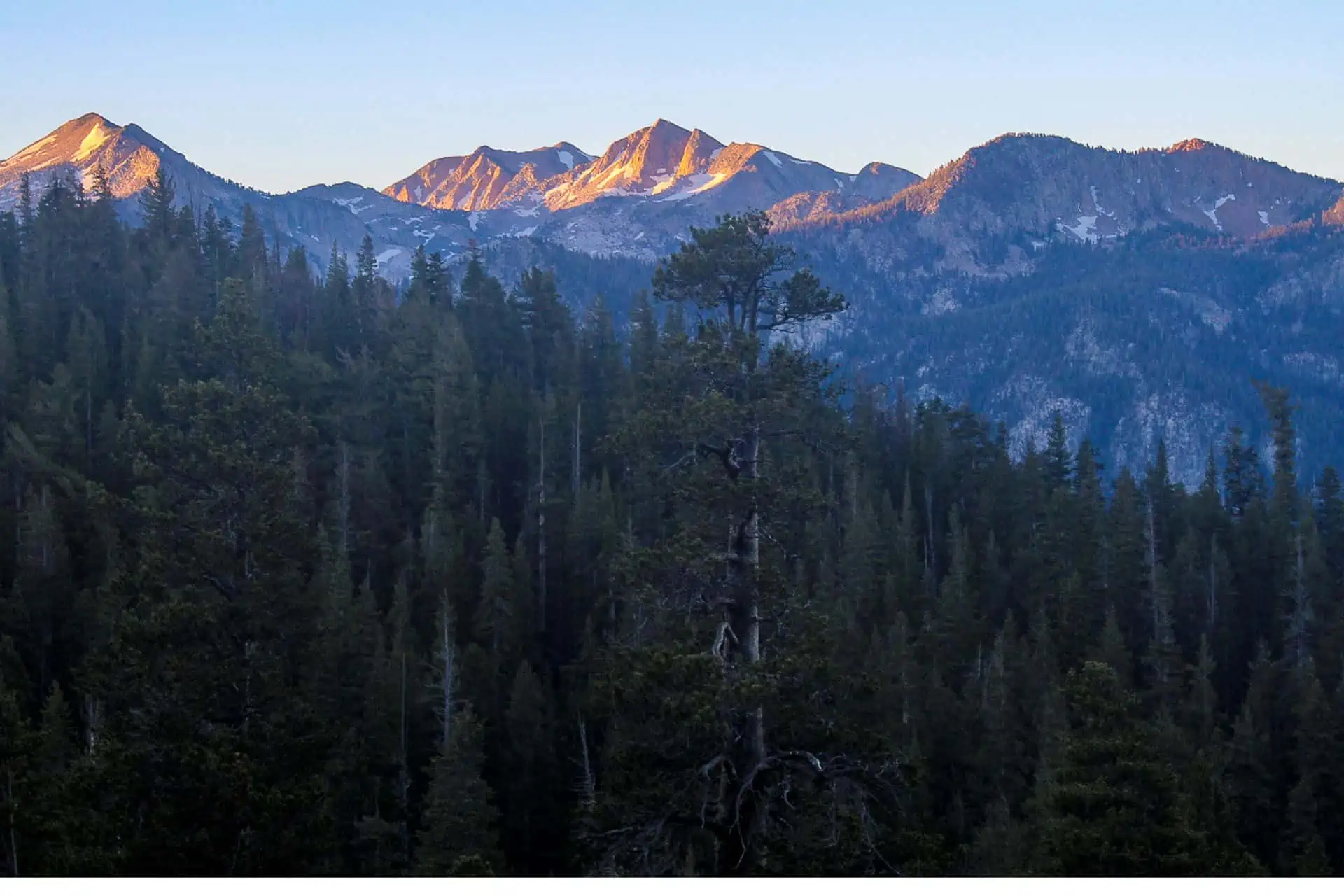John Muir Trail Resupply Guide (2024 Survey)
This John Muir Trail Thru-Hiker Survey installment covers the JMT’s biggest (perceived) logistical issue: resupply. After hikers get their gear sorted, questions surrounding resupply become the object of JMT hiker fascination and internet probing.
What is JMT resupply? It’s the replenishment of the food (and other consumable items) carried in a hiker’s backpack. Basically, buying more food and supplies on the trail. Can you bring all your food for the entire JMT from the start? Sure. However, most people will opt to resupply at some point because the alternative means either moving quickly or carrying an extremely overpacked bear canister.
I often advise hikers to avoid resupplying before beginning a thru-hike. Still, the John Muir Trail isn’t an incredibly long hike compared to something like the 2,600-mile / 4,200-km Pacific Crest Trail, so planning resupply isn’t a crazy idea – in fact, it could even be beneficial.
Using data from the 2024 John Muir Trail Hiker Survey, I’ve compiled the following picture of resupply for a John Muir Trail thru-hike. Hopefully, this will help all you would-be JMT thru-hikers rest a little easier.
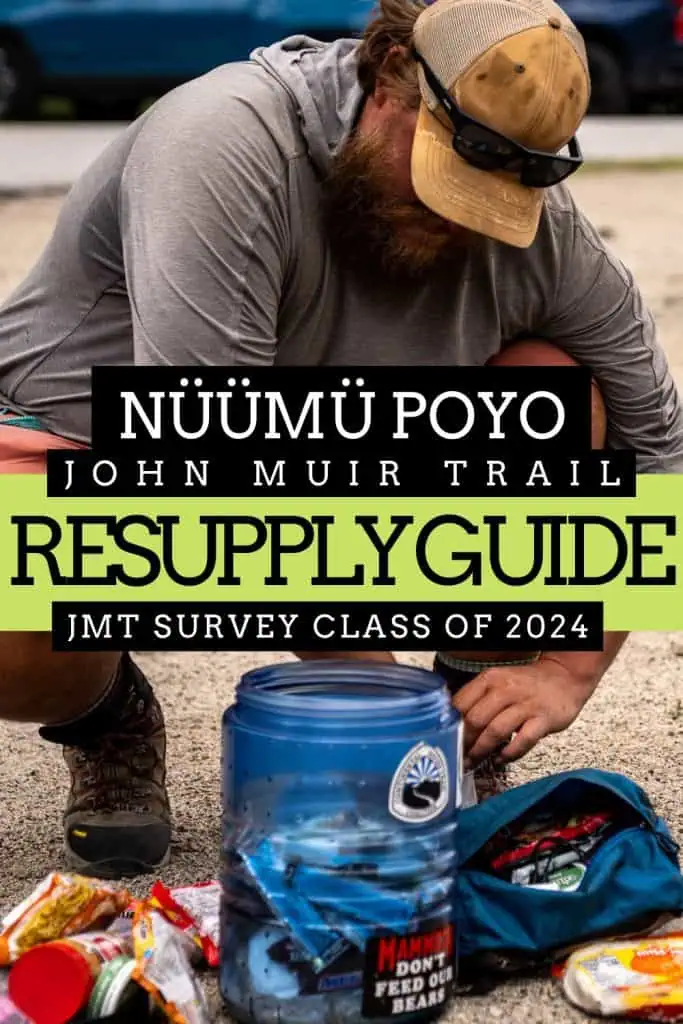
Affiliate Disclosure: This page may contain affiliate links, which means I may receive small commissions for purchases made via these links at no additional cost to you. This helps pay the bills and keep the site up and running. Thank you for your support!
Notes on the Data
- There were 468 completed surveys. Sign up for the survey here if you’re hiking the John Muir Trail next year.
- Some responses have been sorted and colored (e.g., northbound vs. southbound responses).
- I refer to respondents collectively as the year’s “class.” Remember, this is a sample, not a comprehensive survey of every JMT hiker.
- For stats requiring the length of the John Muir Trail for a calculation (e.g., average mileage per day), I use 214.3 mi / 344.88 km. This is the distance, according to FarOut (which I recommend downloading if you don’t already have it).
- I will release more detailed posts focused on other aspects of the John Muir Trail Survey data. To be notified of new posts, click here.
Colors differentiating hiker segments:
- Thru-Hikers
- Northbound Thru-Hikers
- Southbound Thru-Hikers
- The number (1) is appended when only using data from hikers who completed the trail.
- The number (0) is appended when only using data from hikers who did not complete the trail.
If no color/label has been appended to a data point, I used all collected data (i.e., it includes section hiker data and data from hikers who did not complete the trail).
Resupply Strategy
When you reach a town or “resupply stop” along the John Muir Trail, you have the following options:
- Buy a full resupply (replenish your food stocks from zero back to a level sufficient to get you to the next resupply point)
- Buy a partial resupply (boost your current stock to get you through to the next resupply point – i.e., get more snacks)
- You can pick up a package you’ve sent ahead to yourself from a post office or hiker-friendly place along the trail (like a hotel).
- Get a large enough meal to last you until the next resupply stop.
- Skip the stop entirely and crush miles to your next resupply.
Resupply Boxes
Buying your food and prepping boxes before your hike can be tempting for the first-time thru-hiker, even the experienced but uncertain thru-hiker. A certain (false) sense of security comes from packing up resupply before the trail – a kind of “well, I’ve got all that sorted out.” Except on the trail, all that planning/sorting you did beforehand can prove more of a liability than an asset.
Plans change, post offices aren’t always open, boxes get lost, and hikes end early – a lot can happen between your start date and the resupply box you hop(ed) to retrieve.
On top of that, unless you’ve done a long-distance hike before (and based on the statistics from the JMT Survey – you probably haven’t), it can be hard to imagine what you, in a month (or two…or three…), are going to want to eat all day.
Resupply Strategy
- 83.6% – Mailed all resupply
- 7.7% – Mailed some resupply
- 8.7% – Mailed no resupply
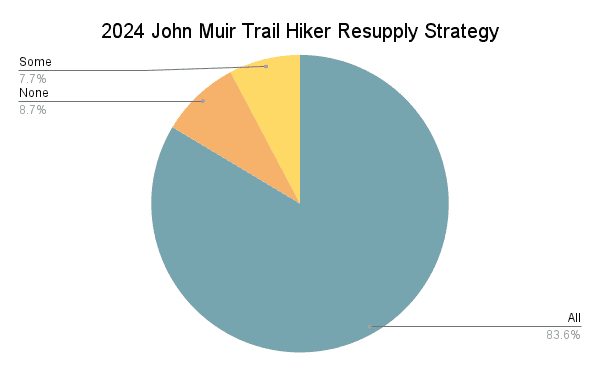
Number of Resupply Boxes
This chart shows the number of resupply boxes sent by thru-hikers (1). If you’re paying attention, this is why the number of hikers who sent zero boxes, according to this graph, is different from the above graph (because the above shows all hikers, not simply those who finished).
Average: 1.96
Median: 2
σ: 1.12
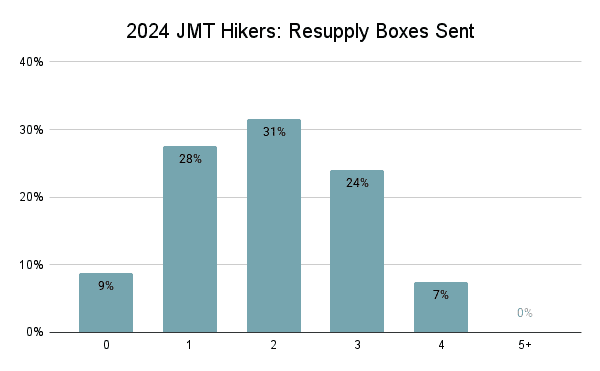
Remember, there is no correct “number of JMT resupply boxes,” but there are places where a prepackaged and curated selection of your preferences will be preferable to the local selection.
Where to Mail JMT Resupply Boxes
As part of the JMT Survey, I asked hikers where they recommend sending a resupply box. Hikers’ motivations for sending a resupply box to a location on the trail can range from “the selection is bad, and everything is expensive” to “I have specific dietary restrictions and require specially prepared food.”
Regardless of their reasons, here’s where the JMT Class of 2024 thinks you should send yourself resupply boxes.
If there’s any confusion, the locations are listed in geographical order from north to south. The percentages reflect the percentage of this year’s class who indicated that they would “definitely send a resupply box” to each location.
Resupply Box Suggestions
- Tuolumne Meadows – 11.3%
- June Lake – 0.3%
- Red’s Meadow – 42.6%
- Mammoth Lakes – 2.8%
- Vermilion Valley Resort – 46.4%
- Muir Trail Ranch – 50.8%
- Bishop – 1.9%
- Independence – 26.0%
- Lone Pine – 1.9%
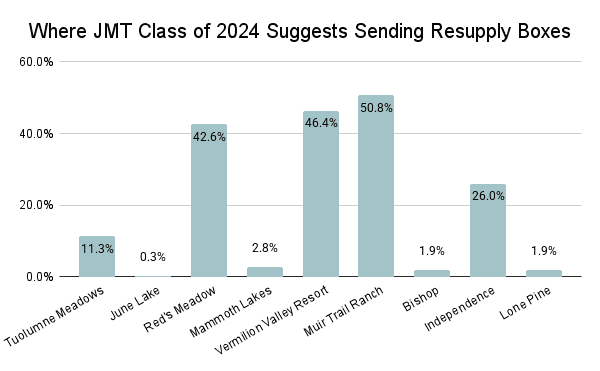
Changes to JMT Resupply Strategy
To help future John Muir Trail hikers figure out a successful JMT resupply strategy, I ask hikers what they would have changed regarding resupply. This year, 62.9% of thru-hikers said they would change something about their resupply strategy.
Here are the responses of those who said they would like to change something.
- 44.6% – Include less food in their resupplies
- 40.2% – Include more variety in their resupplies (Clif Bars and Stroopwafels will only get you so far)
- 17.4% – Resupply more frequently (more frequent resupplies mean less weight carried, but also more time in town)
- 12.5% – Resupply less frequently (less frequent means longer distances between resupplies)
- 11.2% – Include healthier food in their resupplies (yes, you can survive on M&M’s – but should you?)
- 10.3% – Send fewer resupply boxes
- 8.0% – Use a pack service (to have a resupply brought into them while on the trail)
- 6.3% – Send more food in their resupplies
- 2.7% – Prepare all their resupply boxes ahead of time
- 2.2% – Send more resupply boxes
- 1.8% – Prepare no resupply boxes ahead of time
- 1.3% – Would choose not to use a pack service
Favorite Hiker Meals & Snacks
Another John Muir Trail resupply consideration? What foods are you going to be resupplying with?
I would love to eat a Costco-sized bag of M&M’s with a large brick of cheese and a bottle of Sriracha for each section of the trail, but I’ve been told this isn’t healthy (and 11.2% of JMT hikers said they wish they had resupplied with more nutritious food).
What do JMT hikers eat? Berries, insects, dirt, fallen JMT hikers? Obviously. But there’s so much more on offer at (some) JMT resupply stops.
Here are this year’s favorite dehydrated meals and backpacking snacks.
Favorite Backpacking Meals
- Peak Refuel 37.1%
- Mountain House 28.4%
- Ramen 25.8%
- Backpacker’s Pantry 21.6%
- Idahoan Mashed Potatoes 20.8%
- Good To-Go 14.0%
- Packit Gourmet 8.4%
- Knorr Rice Sides 7.9%
- Couscous 6.7%
- AlpineAire Foods 6.5%
Favorite Backpacking Snacks
- Dried Fruit 32.7%
- Beef Jerky 28.6%
- M&M’s 25.5%
- Trail Mix 21.7%
- Peanut Butter 21.2%
- Cheese 20.7%
- Honey Stinger Waffles 17.9%
- Snickers Bars 16.6%
- Clif Bars 15.3%
- Sour Patch Kids 15.3%
How Frequently to Resupply
Many hikers attempt to predict where to resupply before beginning a thru-hike, despite my telling them it’s unnecessary. Do you know how long it will take to walk 75 mi / 120 km with two days of unscheduled rain, a hole in your shoe, and too much food in your pack?
The weather, your physical condition, the people you’re with, where you’ve just come from, where you’re going, and many other factors make this a (somewhat) educated guess at best.
Maybe you’ll prefer carrying more food and resupplying less often, or a lighter load with more frequent stops in town. Perhaps you’ll be injured or quit on the first day, and none of this will matter.
So, what’s the right balance between resupplying and hiking? It’s different for everyone. Here’s a look at this year’s hiking resupply.
Thru-Hikers (1)
18.8
The average number of days of an entire thru-hike
M = 19 | σ = 6.1
Thru-Hikers (1)
1.0
The average number of zero days taken during a thru-hike
(M = 1 | σ = 1.1)
Thru-Hikers (1)
1.1
The average number of nearo days (low mileage days)
(M = 1 | σ = 1.1)
Thru-Hikers (1)
2.3
The average number of resupplies over the entire trail
(M = 2 | σ = 1)
Thru-Hikers (1)
9.3
The average number of days between resupplies
(M = 7.7 | σ = 4.4)
Thru-Hikers (1)
70.1
The average number of miles between resupplies (112.8 km)
(M = 71 mi / 114 km | σ = 22 mi / 35 km)
Average JMT Resupply Plan
Based on survey responses, we can assemble an “average” John Muir Trail hiker’s resupply for a thru-hike this year. Below is a list of all the JMT resupply stops where hikers stopped this year, accompanied by the percentage of hikers who stopped at each location.
Locations are listed in geographical order from north to south. I use the following colors to indicate each resupply stop’s popularity: over 75%, 50-75%, 25-50%, and below 25%.
⛺ Stops that can be reached without hitchhiking (i.e., they’re either on the trail or a relatively short – and relatively safe – detour)
- ⛺ Tuolumne Meadows – 12.6%
- Lee Vining – 0.3%
- ⛺ Red’s Meadow – 47.2%
- Mammoth Lakes – 8.3%
- ⛺ Vermilion Valley Resort (VVR) – 43.5%
- ⛺ Muir Trail Ranch – 54.2%
- Bishop (via Piute Pass/North Lake) – 4.0%
- Bishop (via Bishop Pass/South Lake) – 4.0%
- ⛺ Parchers Resort – 1.3%
- ⛺ Sequoia Kings Pack Station – 2.3%
- ⛺ Woods Creek via CGPS – 0.7%
- ⛺ Charlotte Lake via pack train – 0.7%
- ⛺ Friend hiking in resupply over Kearsarge Pass – 2.7%
- ⛺ Onion Valley (cache or food delivery) – 14%
- Bishop (via Kearsarge Pass/Onion Valley) – 5.0%
- Independence (via Kearsarge Pass/Onion Valley) – 30.2%
- Independence (via Horseshoe Meadow) – 1.0%
Favorite (& Least Favorite) Resupply Stops
The John Muir Trail is mostly about hiking, but the resupply stops also play a role in the JMT experience (for most hikers). I ask about hikers’ favorite and least favorite resupply points. When asking this question, I specify that “favorite/least favorite” means where hikers most/least enjoyed, not which locations had the best/worst resupply options (although these could be the same).
Favorite Resupply Stop
Vermilion Valley Resort (VVR)
60.6% of hikers voted for VVR
Least Favorite Resupply Stop
Muir Trail Ranch
42.3% of hikers voted for MTR
Dietary Restrictions
Not all hikers can subsist on gas station beef jerky and trail mix. I asked hikers if they had dietary restrictions and what they were. Each dietary restriction is also given a rating by hikers based on how difficult it was to adhere to this dietary restriction while on the trail (0 being not difficult and 10 being nearly impossible).
Dietary Restrictions
- 22.2% Yes
- 77.8% No
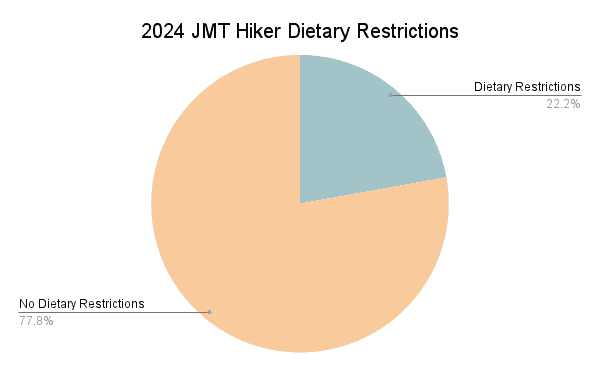
Specific Dietary Restrictions
- Vegetarian – 30.1%
- Dairy-free – 20.4%
- Gluten-free – 18.4%
- Beef-free – 17.5%
- Lactose intolerance – 17.5%
- Vegan – 15.5%
- Pescatarian – 8.7%
- Lactose-free – 6.8%
- Keto – 4.9%
- Peanut allergy – 4.9%
- Tree-nut allergy – 4.9%
- Diabetic – 1.9%
- Histamine intolerance – 1.0%
- Kosher – 1.0%
- Other – 3.9%
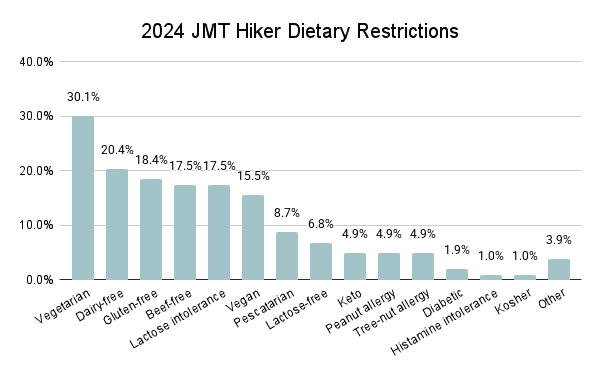
Note: These percentages are of hikers with dietary restrictions.
Dietary Difficulties
- Histamine intolerance 4
- Keto 3.8
- Gluten-free 2.8
- Tree-nut allergy 2.2
- Lactose-free 2
- Vegetarian 1.4
- Dairy-free 1.1
- Vegan 1.1
- Beef-free 1
- Lactose intolerance 0.9
- Peanut allergy 0.8
- Pescatarian 0.7
- Diabetic 0
- Kosher 0
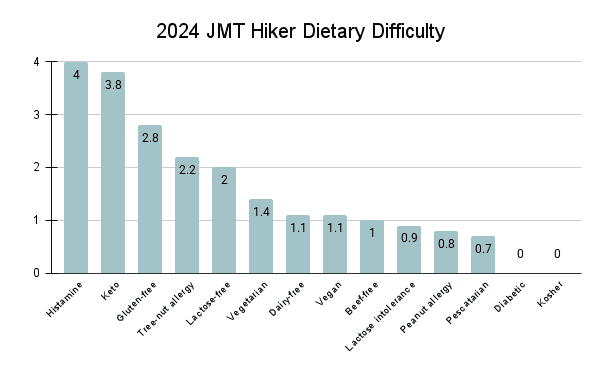
Note: These are on a scale of 0 to 10, with 10 being the most difficult to adhere to and zero being the easiest.
Resupply Advice
Enough with the numbers, colors, graphs, labels, and bulleted lists of places you may or may not have ever heard of. What did thru-hikers have to say about John Muir Trail resupply? The following is advice, each from an individual hiker, regarding JMT resupply.
Remember, each of these represents a single person’s opinion; none should be taken as JMT gospel.
- A good idea is to pack a variety of food in your boxes. Don’t pack the same thing in every box; you’ll end up hating it if you eat it every day.
- Definitely leave enough time for Muir Trail Ranch to get the package. They really do need the full two weeks.
- Don’t repack your jerky until you get your resupply. Our got moldy because we put it in Zip-loc bags before sending it. Send lots of variety and comfort foods. Send lots of ibuprofen.
- I sent four Coke cans in the resupply box. At MTR, I gave two to other hikers to their shock and delight. Send yourself some of your favorite drinks to MTR. You can consume them while there and then trash them. I would only go northbound, as you can send a four-day resupply to MTR and buy further supplies at Red’s or Mammoth. If you plan your trip for the right month, you can also purchase food at the Tuolumne store.
- If starting at Happy Isles, carry the first two days of food with you and resupply at the Tuolumne Meadow Store to avoid lugging five to six days of food out of the Valley. Resupplies at Red’s and MTR were excellent and convenient. Pack way less food than you think you’ll need – I gave away at least half (if not more) of the food I had packed initially and in my resupplies!
- Practice packing your bear canister so you know everything will fit.
- Sending a box to VVR isn’t worth it! You can pick through the hiker box or buy stuff at the store. Even with the high prices, you’ll save more than the $40+ shipping.
- The northern half of the trail has lots of stores and hiker boxes. If you can afford it, you can get away with packing very light or not sending a resupply box and relying on those.
- VVR is more than a resupply: It is a summer camp for adults! We met so many wonderful thru-hikers there, some of whom we continued to spend time with later on the trail. If you are not resupplying at MTR, do not bother with a visit there. They offer free recharging, water, and handwashing, but there is no store.
If you can think of anything that would make this resupply information more useful (or if you would like to see any more cross-referencing related to resupply), please comment and let me know.
For more on JMT Resupply, check out these posts.
Support the Survey
Every year, I get a lot of people asking how to support the surveys. Beyond sharing them with your close-knit bubble of weird hiker friends, the best way to support the survey is to contribute via Patreon. You’ll get access to exclusive posts, discount codes, live streams, and super, extra cool stickers so that everyone will know how cool you are.
If you’re not into Patreon, that’s cool; you can Venmo @halfwayanywhere, Cash app $halfwayanywhere, or PayPal moc.erehwynayawflah@tcatnoc
This is not expected. The data collected in the survey will always be free and accessible to everyone who wants/needs it. Your support is much appreciated and helps pay the website (and survey) bills.
